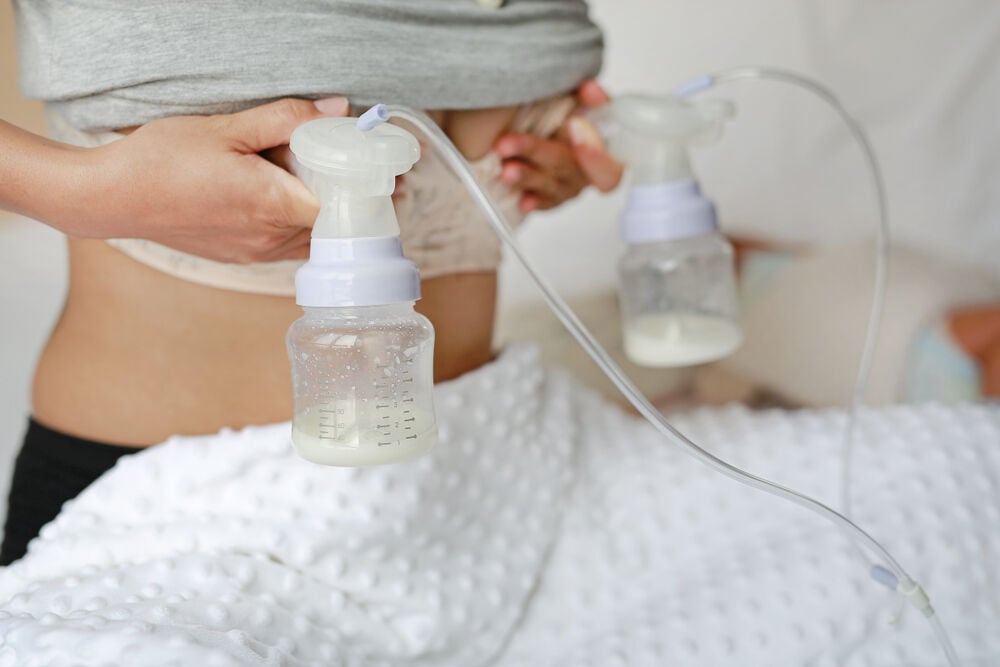-
Tracking cycle
-
Getting pregnant
-
Pregnancy
-
Help Center
-
Flo for Partners
-
Anonymous Mode
-
Flo app reviews
-
Flo Premium New
-
Secret Chats New
-
Symptom Checker New
-
Your cycle
-
Health 360°
-
Getting pregnant
-
Pregnancy
-
Being a mom
-
LGBTQ+
-
Quizzes
-
Ovulation calculator
-
hCG calculator
-
Pregnancy test calculator
-
Menstrual cycle calculator
-
Period calculator
-
Implantation calculator
-
Pregnancy weeks to months calculator
-
Pregnancy due date calculator
-
IVF and FET due date calculator
-
Due date calculator by ultrasound
-
Medical Affairs
-
Science & Research
-
Pass It On Project New
-
Privacy Portal
-
Press Center
-
Flo Accuracy
-
Careers
-
Contact Us
Pumping Breast Milk Basics: How to Use a Breast Pump with No Worries

Every piece of content at Flo Health adheres to the highest editorial standards for language, style, and medical accuracy. To learn what we do to deliver the best health and lifestyle insights to you, check out our content review principles.
How to use a breast pump: what you should know
Learning to use a breast pump can take some time. Be patient if you're not producing as much milk as you'd like at first. Your body will gradually learn to stimulate the let-down reflex when you pump, increasing the amount of breast milk that you express.
When to start pumping
If you're planning to pump when you return to work, start practicing one or two weeks before you're planning to go back. This can help you learn how your pump works. You can pump immediately after the baby eats or in between feedings. You can also pump from one of your breasts while feeding your child from the other.
How often should you pump?
Try pumping as frequently as your child generally eats, maybe every three to four hours. You can also pump immediately after your child eats, which helps increase the production of breast milk.
How long should you pump?
Pumping breast milk takes about as long as breastfeeding. With regular practice, it may take you between 10 and 15 minutes to pump from both breasts using a good electric breast pump. It may take about 30–45 minutes to pump using a hand-operated breast pump.
How much milk should you be pumping?
The amount of milk you pump depends on how old your baby is, the time of the day, the time since the last pumping or feeding, the type of pump, whether you are stressed or relaxed, and the amount of practice you've had with the pump. If you are mainly breastfeeding your baby, you can expect the following:
- Increased amount of breast milk in the morning
- Decreased milk volume in the afternoon and evening
If you are predominantly pumping breast milk, you may pump about 25 to 35 oz (750 to 1,035 mL) of milk a day. Don't worry if you're not producing this much on the first day. It may take some time before the amount of milk you produce becomes regular.
Breastfeeding and pumping schedule
Some example breastfeeding and pumping schedules are as follows:
Breastfeeding and pumping schedule one
6:00 AM Breastfeed
7:00 AM Pump
8:00 AM Breastfeed
10:00 AM Pump
1:30 PM Pump
5:30 PM Breastfeed
7:00 PM Breastfeed
9:30 PM Breastfeed
11:00 PM Pump
3:00 AM Breastfeed if your baby wakes up
Breastfeeding and pumping schedule two
5:00 AM Pump
6:00 AM Breastfeed
7:35 AM Breastfeed
10:35 AM Pump
12:35 PM Pump
3:05 PM Pump
6:05 PM Breastfeed
7:35 PM Breastfeed
11:05 PM Breastfeed and pump
Breastfeed your baby during the night on demand

Take a quiz
Find out what you can do with our Health Assistant
Follow these breast pumping tips to make the process easier:
- Practice pumping at home before you try it on the go or at work. Start practicing at least one or two weeks before you go back to work to get comfortable with the breast pump. Remember that you may not be able to pump much milk initially.
- Stick to your baby's schedule and pump as often as you feed your baby. If you aren't able to do this, then pump during your regular break times.
- Wear clothes that make pumping easier. It's easiest to pump if your top opens at the front. If you're pumping in the car, it can be handy to keep a shawl or blanket in the back seat to provide some coverage and privacy.
- Make sure that you are comfortable when pumping. During the initial 10 to 15 seconds, it might feel a little uncomfortable as your nipples begin to stretch. After that, as the milk starts flowing, you may get a tingling sensation. Pumping shouldn't ever hurt.
- To help the flow of your milk, relax for a couple minutes. Gently massaging your breasts or placing a warm compress on your chest may help. You can also keep a blanket or piece of clothing from your baby that smells like them to stimulate the milk let down.
- Give yourself as much time as you need. With regular practice, pumping breast milk takes about as long as breastfeeding. It might take some additional time to wash your hands, get comfy, set up the pump, and clean up after pumping.
- Store milk immediately after pumping. You can store it at room temperature (less than 77 degrees F) for four to six hours. It's usually best to store breast milk in the refrigerator as soon as possible. Breast milk can last in the freezer for 6 to 12 months.
How to produce more breast milk
These tips can help you produce more breast milk:
- Relax while pumping. Stress can make it harder for your body to produce breast milk. Sit in a quiet, relaxing place while pumping.
- Pump frequently as this will increase the amount of milk your breasts produce. If possible, simultaneously pump both breasts. When you use a double breast pump, it helps stimulate the milk production and reduces the time it takes.
- When you and your baby are together, try to breastfeed them on demand. This increases the supply of your breast milk when pumping.
- Formula feedings can decrease your baby's demand for breast milk. This can ultimately reduce your production of milk.
- Drink lots of fluids to stay hydrated. Limit your intake of coffee, soda, and other caffeinated drinks.
- Smoking may decrease your milk production.
- Eat a well-balanced, healthy diet that includes whole grains and lots of fruits and vegetables. Add physical activity to your daily regimen. Sleep when your baby sleeps, and ask help from your support network whenever you need it.


Hey, I'm Anique
I started using Flo app to track my period and ovulation because we wanted to have a baby.


The Flo app helped me learn about my body and spot ovulation signs during our conception journey.


I vividly
remember the day
that we switched
Flo into
Pregnancy Mode — it was
such a special
moment.
Real stories, real results
Learn how the Flo app became an amazing cheerleader for us on our conception journey.




